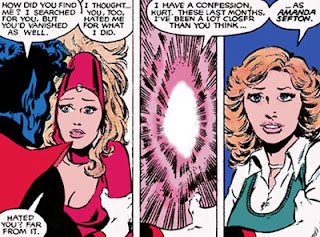In the midst of his birthday celebration amid the other X-Men, Nightcrawler’s soul is stolen from his body. With the help of Doctor Strange, the X-Men conjure forth the spectre of the entity responsible for their friend’s “death:” a sorceress named Margali. She pulls Strange and the X-Men into the same other-dimensional prison to which she’s condemned Nightcrawler's soul: a world fashioned to resemble Dante’s Inferno.
Once the mutants and the master magician find their quarry, his “soul” has the same solidity as his body, and the heroes battle against the various demons as they follow Dante’s course of escape: descending to the center of hell. Once there, Margali reveals herself, but claims that she had nothing to do with the other heroes appearing in her other-dimensional world.
Her daughter Jimaine appears, attesting that she was actually responsible for bringing the other heroes to the hell-world, to help Nightcrawler. Margali relates that she became Nightcrawler’s foster mother when he was an orphaned infant, and that she raised him beside her natural children Jimaine and Stefan. However, Stefan apparently went mad and slaughtered people, forcing Nightcrawler to slay the young man. Margali, upon learning the truth, forgives her foster son and returns everyone, including Jimaine, to the real world.
At this point Jimaine reveals that she’s been watching over Nightcrawler for some time, disguising herself as a young woman, Amanda, whom Nightcrawler has been dating. This revelation—that Nightcrawler has been dating his foster sister—and perhaps more than dating, since he references “all we’ve done together”—raises the possibility that Nightcrawler might have had romantic relations with Jimaine while still living with her, Margali, and Stefan. Indeed, the tenuous explanation allotted to Stefan’s madness suggests that author Chris Claremont might have tossed in that rationale in place of some variation of “the Laertes trope,” in which a devoted brother seeks to kill his sister’s lover, whether out of sexual jealousy or mere protectiveness.







No comments:
Post a Comment